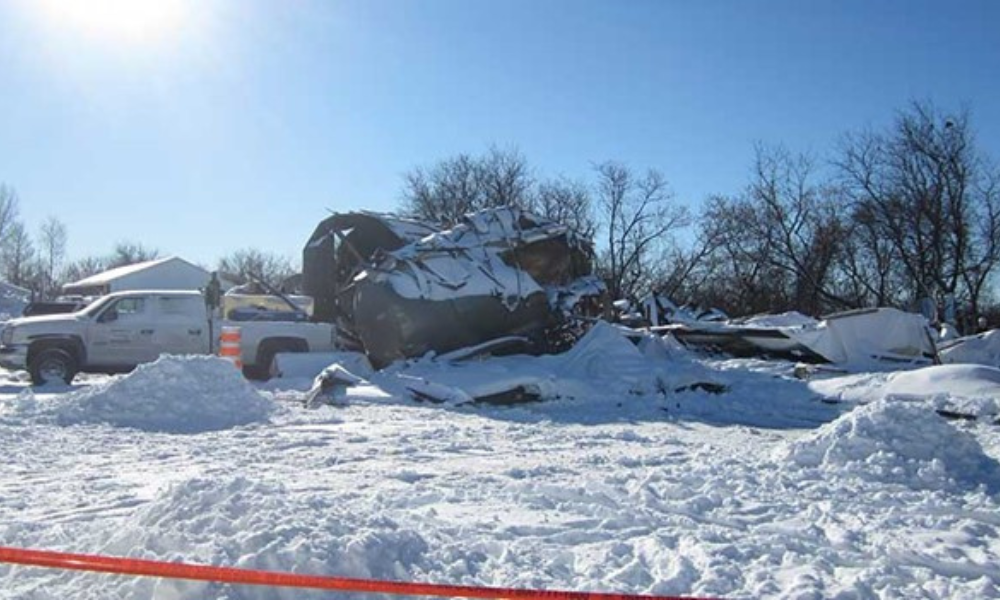Gasoline vapours ignited during welding on a tank trailer inside a garage

The Commission for Standards, Equity, Health and Safety at Work (CNESST) has released its findings regarding the tragic explosion and fire that claimed the lives of three workers at Propane Lafortune (Gaston R. Lafortune Inc.) on January 12, 2023 in St-Roch-de-l’Achigan, Quebec.
An investigation report sent by CNESST to Canadian Occupational Safety reveals at the time of the incident a worker from Soudure A.C. was conducting welding work on the chassis of a tank trailer containing hydrocarbons inside the garage of Propane Lafortune.
“Gasoline vapors ignited inside a compartment of the tank, which caused the explosion, followed by a fire in the building," reads the report. The explosion and fire destroyed the building and killed the welder as well as two office employees at Propane Lafortune.
The incident sent shockwaves through the community of Saint-Roch-de-l'Achigan, prompting an in-depth investigation into the causes and recommendations to prevent similar accidents in the future.
The report states, “welding activities carried out inside the building on a tank trailer containing gasoline vapours posed a significant risk to the workers present.”
In response to the accident, the CNESST took immediate actions, prohibiting the company from removing rubble from the site without the presence of a CNESST inspector. Additionally, the company was forbidden from conducting any hot work near tanks containing combustible or flammable products.
The CNESST mandated the development and implementation of stringent safety procedures for such tasks. Soudure A.C. was also prohibited from performing welding work near hydrocarbon-containing tanks and in repair pits. They were required to establish safe working methods.
Recommendations for prevention
The CNESST has outlined a series of recommendations to prevent accidents during welding work and when working with flammable products. These include:
- Risk analysis: Prior to any hot work, a thorough risk analysis must be conducted to identify, control, and eliminate potential hazards.
- Eliminating ignition sources: All potential sources of ignition, including electrical installations within the vicinity of flammable vapors, must be eliminated.
- Safe distances: Welding and cutting should be conducted at a distance of more than 11 meters from combustible and flammable materials, unless all ignition risks are identified and controlled.
- Proper storage: Parking tank vehicles inside buildings not specifically designed for this purpose should be prohibited.
- Inspection and cleaning: Tank vehicles must undergo thorough exterior inspections and cleaning to ensure there are no leaks in the tank, piping, or valves before they are parked inside.
- Avoiding work on contaminated containers: Whenever possible, welding, cutting, or heating work should not be performed on containers that have contained combustible materials or materials likely to release toxic or flammable vapors under the influence of heat.
- Cleaning and purging: Containers and tanks should be cleaned to remove any combustible or heat-sensitive materials. If hazards persist, they should be purged with inert gas or filled with water to a safe level.
- Worker training: Workers should be educated about the risks associated with their tasks, receiving proper training and supervision to develop the necessary skills and knowledge.
Follow-up of the investigation
The CNESST will share the investigation's findings with various industry associations, including the Canadian Fuels Association, the Quebec Association of Petroleum Independents, the Canadian Gas Association, the Quebec Propane Association, the Quebec Trucking Association, joint sectoral associations, and mutual prevention society managers, to ensure that their members are informed and can implement necessary safety measures.
The full investigation report will also be distributed to training institutions offering welding-assembly study programs.





